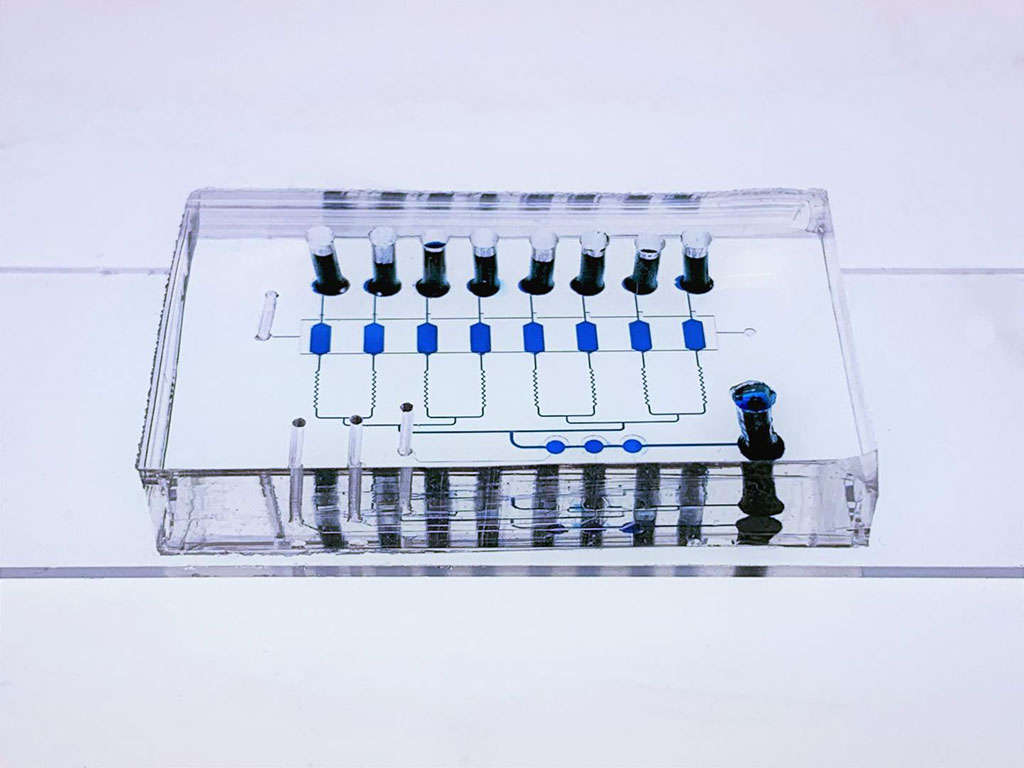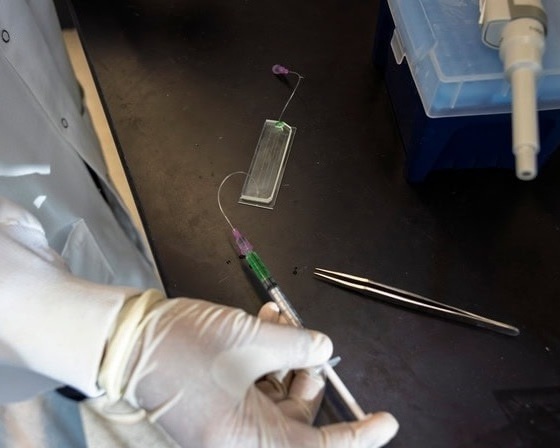A Novel Liquid Biopsy Device Enables Early Cancer Detection and Diagnosis
|
By LabMedica International staff writers Posted on 22 Jun 2020 |

Image: The multi-layer EV-CLUE chip device. The microreactors and connecting channels are visualized by filling with blue food dye. The bottom glass slide is patterned with nanoparticle structures and coated with antibody to capture extracellular vesicles (Photo courtesy of Dr. Yong Zeng)
A novel liquid biopsy device for early cancer detection and diagnosis was used to isolate and analyze extracellular vesicles from breast cancer tumors.
Evidence has accumulated, which indicates that extracellular vesicles (EVs) have important functions in tumor progression and metastasis, including matrix remodeling via transporting matrix metalloproteases (MMPs).
Proteins of the matrix metalloproteinase (MMP) family are involved in the breakdown of extracellular matrix in normal physiological processes, such as embryonic development, reproduction, and tissue remodeling, as well as in disease processes, such as arthritis and metastasis.
In the meantime, the clinical relevance of EVs has remained largely undetermined, partially owing to challenges in EV analysis. EVs, which contain RNA, proteins, lipids, and metabolites that are reflective of the cell type of origin, are increasingly being recognized as important vehicles of communication between cells and as promising diagnostic and prognostic biomarkers in cancer. Despite this huge clinical potential, the wide variety of methods for separating EVs from biofluids, which provide material of highly variable purity, and the lack of knowledge regarding methodological reproducibility have impeded the entry of EVs into the clinical arena.
To open up the clinical potential for analysis of EVs, investigators at the University of Kansas (Lawrence, USA) developed a generalized, high-resolution colloidal inkjet printing method that allowed robust and scalable manufacturing of three-dimensional nanopatterned devices. These nanopatterned polydimethylsiloxane/glass microfluidic chips (EV-CLUE chips) were used to analyze EVs in plasma. The chips captured EVs expressing different surface markers of interest and measured the expression and activity of the EV-bound enzyme MMP14.
The EV-CLUE chip is a multi-layer device constructed by stacking two slabs made of polydimethylsiloxane (PDMS) on a glass slide. The top PDMS slab was microfabricated with a network of pressure/vacuum valves and pump that controlled the circuit of eight parallel microreactors engraved on the middle thin PDMS layer. The bottom glass slide was patterned with nanoparticle structures and coated with antibody to capture extracellular vesicles.
Analysis of clinical plasma specimens showed that EV-CLUE technology could be used for cancer detection including accurate classification of age-matched controls and patients with ductal carcinoma in situ, invasive ductal carcinoma, or locally metastatic breast cancer in a training cohort (n = 30, 96.7% accuracy) and an independent validation cohort (n = 70, 92.9% accuracy).
The investigators expect that their EV-CLUE technology will provide a useful liquid biopsy tool to improve cancer diagnostics and real-time surveillance of tumor evolution in patients, which would be another step on the road to truly personalized cancer therapy.
The EV-CLUE device was described in the June 10, 2020, online edition of the journal Science Translational Medicine.
Related Links:
University of Kansas
Evidence has accumulated, which indicates that extracellular vesicles (EVs) have important functions in tumor progression and metastasis, including matrix remodeling via transporting matrix metalloproteases (MMPs).
Proteins of the matrix metalloproteinase (MMP) family are involved in the breakdown of extracellular matrix in normal physiological processes, such as embryonic development, reproduction, and tissue remodeling, as well as in disease processes, such as arthritis and metastasis.
In the meantime, the clinical relevance of EVs has remained largely undetermined, partially owing to challenges in EV analysis. EVs, which contain RNA, proteins, lipids, and metabolites that are reflective of the cell type of origin, are increasingly being recognized as important vehicles of communication between cells and as promising diagnostic and prognostic biomarkers in cancer. Despite this huge clinical potential, the wide variety of methods for separating EVs from biofluids, which provide material of highly variable purity, and the lack of knowledge regarding methodological reproducibility have impeded the entry of EVs into the clinical arena.
To open up the clinical potential for analysis of EVs, investigators at the University of Kansas (Lawrence, USA) developed a generalized, high-resolution colloidal inkjet printing method that allowed robust and scalable manufacturing of three-dimensional nanopatterned devices. These nanopatterned polydimethylsiloxane/glass microfluidic chips (EV-CLUE chips) were used to analyze EVs in plasma. The chips captured EVs expressing different surface markers of interest and measured the expression and activity of the EV-bound enzyme MMP14.
The EV-CLUE chip is a multi-layer device constructed by stacking two slabs made of polydimethylsiloxane (PDMS) on a glass slide. The top PDMS slab was microfabricated with a network of pressure/vacuum valves and pump that controlled the circuit of eight parallel microreactors engraved on the middle thin PDMS layer. The bottom glass slide was patterned with nanoparticle structures and coated with antibody to capture extracellular vesicles.
Analysis of clinical plasma specimens showed that EV-CLUE technology could be used for cancer detection including accurate classification of age-matched controls and patients with ductal carcinoma in situ, invasive ductal carcinoma, or locally metastatic breast cancer in a training cohort (n = 30, 96.7% accuracy) and an independent validation cohort (n = 70, 92.9% accuracy).
The investigators expect that their EV-CLUE technology will provide a useful liquid biopsy tool to improve cancer diagnostics and real-time surveillance of tumor evolution in patients, which would be another step on the road to truly personalized cancer therapy.
The EV-CLUE device was described in the June 10, 2020, online edition of the journal Science Translational Medicine.
Related Links:
University of Kansas
Latest Technology News
- Diagnostic Chip Monitors Chemotherapy Effectiveness for Brain Cancer
- Machine Learning Models Diagnose ALS Earlier Through Blood Biomarkers
- Artificial Intelligence Model Could Accelerate Rare Disease Diagnosis
- AI Saliva Sensor Enables Early Detection of Head and Neck Cancer
- AI-Powered Biosensor Technology to Enable Breath Test for Lung Cancer Detection
- AI Model Achieves Breakthrough Accuracy in Ovarian Cancer Detection
- Portable Biosensor Diagnoses Psychiatric Disorders Using Saliva Samples
- Cell-Sorting Device Uses Electromagnetic Levitation to Precisely Direct Cell Movement

- Embedded GPU Platform Enables Rapid Blood Profiling for POC Diagnostics
- Viral Biosensor Test Simultaneously Detects Hepatitis and HIV
Channels
Clinical Chemistry
view channel
Noninvasive Blood-Glucose Monitoring to Replace Finger Pricks for Diabetics
People with diabetes often need to measure their blood glucose multiple times a day, most commonly through finger-prick blood tests or implanted sensors. These methods can be painful, inconvenient, and... Read more
POC Breath Diagnostic System to Detect Pneumonia-Causing Pathogens
Pseudomonas aeruginosa is a major cause of hospital-acquired and ventilator-associated pneumonia, particularly in lung transplant recipients and patients with structural lung disease. Its ability to form... Read moreHematology
view channel
MRD Tests Could Predict Survival in Leukemia Patients
Acute myeloid leukemia is an aggressive blood cancer that disrupts normal blood cell production and often relapses even after intensive treatment. Clinicians currently lack early, reliable markers to predict... Read more
Platelet Activity Blood Test in Middle Age Could Identify Early Alzheimer’s Risk
Early detection of Alzheimer’s disease remains one of the biggest unmet needs in neurology, particularly because the biological changes underlying the disorder begin decades before memory symptoms appear.... Read more
Microvesicles Measurement Could Detect Vascular Injury in Sickle Cell Disease Patients
Assessing disease severity in sickle cell disease (SCD) remains challenging, especially when trying to predict hemolysis, vascular injury, and risk of complications such as vaso-occlusive crises.... Read more
ADLM’s New Coagulation Testing Guidance to Improve Care for Patients on Blood Thinners
Direct oral anticoagulants (DOACs) are one of the most common types of blood thinners. Patients take them to prevent a host of complications that could arise from blood clotting, including stroke, deep... Read moreImmunology
view channel
Blood Test Could Identify Colon Cancer Patients to Benefit from NSAIDs
Colon cancer remains a major cause of cancer-related illness, with many patients facing relapse even after surgery and chemotherapy. Up to 40% of people with stage III disease experience recurrence, highlighting... Read moreBlood Test Could Detect Adverse Immunotherapy Effects
Immune checkpoint inhibitors have transformed cancer treatment, but they can also trigger serious immune-related adverse events that damage healthy organs and may become life-threatening if not detected early.... Read moreMicrobiology
view channel
New UTI Diagnosis Method Delivers Antibiotic Resistance Results 24 Hours Earlier
Urinary tract infections affect around 152 million people every year, making them one of the most common bacterial infections worldwide. In routine medical practice, diagnosis often relies on rapid urine... Read more
Breakthroughs in Microbial Analysis to Enhance Disease Prediction
Microorganisms shape human health, ecosystems, and the planet’s climate, yet identifying them and understanding how they are related remains a major scientific challenge. Even with modern DNA sequencing,... Read morePathology
view channel
AI Tool Simultaneously Identifies Genetic Mutations and Disease Type
Interpreting genetic test results remains a major challenge in modern medicine, particularly for rare and complex diseases. While existing tools can indicate whether a genetic mutation is harmful, they... Read more
Rapid Low-Cost Tests Can Prevent Child Deaths from Contaminated Medicinal Syrups
Medicinal syrups contaminated with toxic chemicals have caused the deaths of hundreds of children worldwide, exposing a critical gap in how these products are tested before reaching patients.... Read more
Tumor Signals in Saliva and Blood Enable Non-Invasive Monitoring of Head and Neck Cancer
Head and neck cancers are among the most aggressive malignancies worldwide, with nearly 900,000 new cases diagnosed each year. Monitoring these cancers for recurrence or relapse typically relies on tissue... Read moreTechnology
view channel
Diagnostic Chip Monitors Chemotherapy Effectiveness for Brain Cancer
Glioblastoma is one of the most aggressive and fatal brain cancers, with most patients surviving less than two years after diagnosis. Treatment is particularly challenging because the tumor infiltrates... Read more
Machine Learning Models Diagnose ALS Earlier Through Blood Biomarkers
Amyotrophic lateral sclerosis (ALS) is a rapidly progressive neurodegenerative disease that is notoriously difficult to diagnose in its early stages. Early symptoms often overlap with other neurological... Read moreIndustry
view channel
BD and Penn Institute Collaborate to Advance Immunotherapy through Flow Cytometry
BD (Becton, Dickinson and Company, Franklin Lakes, NJ, USA) has entered into a strategic collaboration with the Institute for Immunology and Immune Health (I3H, Philadelphia, PA, USA) at the University... Read more






















